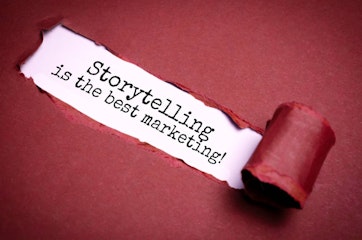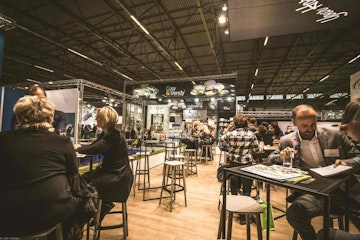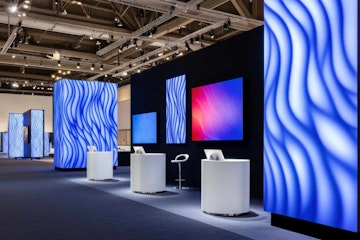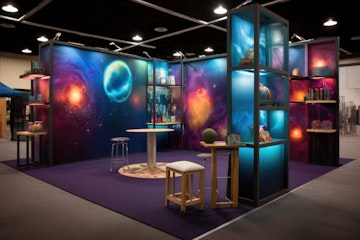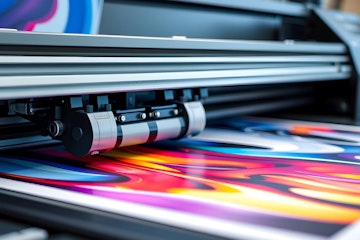Trade shows can be exhilarating, noisy, and ever so slightly overwhelming. If you’ve ever stood in the middle of an exhibition hall and thought, how on earth do I make my stand stand out?, you’re not alone. The truth is, display design matters just as much as your product. Choosing the right type of trade show display can transform a booth from “generic backdrop” to “crowd magnet.”
Below, we’ll walk through seven types of trade show displays - the classics, the versatile, and the ones that make people stop mid-scroll on social media. And somewhere along the way, we’ll also talk about how to think strategically about maximising visibility with the right trade show display. Because it’s not just about looking good; it’s about being seen.
1. Pop-Up Displays
Pop-up displays are the old faithful of trade show setups. They’re lightweight, portable, and quick to assemble (we love anything that can be done before the coffee kicks in). Usually built with a collapsible frame and magnetic panels, they give you a professional backdrop in minutes.
They’re best for small to medium-sized exhibition spaces where you want visual impact without complicated logistics. The graphics can be swapped easily, so if you attend several shows throughout the year, one frame can serve multiple campaigns.
But we’ll admit - they can look a bit standard if not designed well. Choose high-resolution imagery and bold, minimal text. Your message should be clear even from a few metres away. Remember: people rarely squint to read fine print at busy trade shows.
2. Modular Displays
If pop-ups are the starter kit, modular displays are the grown-up version. These systems are made up of interchangeable parts that can be rearranged to fit different booth sizes or layouts. Think of them like LEGO for exhibitors - infinitely configurable and surprisingly elegant.
They’re ideal if you exhibit frequently or across different venues. Yes, they require more investment upfront, but the adaptability pays off. You can create anything from a compact 3x3 booth to a sprawling island display simply by reconfiguring components.
We think modular displays strike a great balance between practicality and polish. They also pair beautifully with digital elements - touch screens, lighting features, even small demo stations - giving you creative freedom to shape how visitors move through your space.
3. Banner Stands and Roller Banners
Ah, the humble banner stand. Simple, sleek, and incredibly effective when used right. Roller banners, in particular, are popular because they’re affordable and easy to transport. You literally roll them up, tuck them in a carry case, and off you go.
These are perfect for smaller events or as supplementary visuals alongside larger setups. Use them to highlight key messages, promote offers, or direct attention to interactive areas. And if you’re just starting out, investing in portable display banners for events is a no-brainer - they’re budget-friendly yet can make a striking impression with the right design.
Just avoid the temptation to cram too much text. White space is your friend. So are sharp images and consistent branding.
4. Tabletop Displays
Tabletop displays are small but mighty. Often used at conferences, recruitment fairs, or networking events, they sit neatly on a standard table yet still command attention. Usually made of lightweight panels or folding boards, they’re portable enough to fit in the boot of a car.
They work best when you have limited space or when you’re one exhibitor among many - say, in a university fair or local business showcase. Pair them with well-placed literature, branded giveaways, and clear signage to make a compact setup feel intentional rather than improvised.
Some exhibitors underestimate tabletop displays, but we’d argue they’re the most efficient per-square-foot marketing tool around. A crisp, cohesive design can make your table the one people remember.
5. Truss Systems
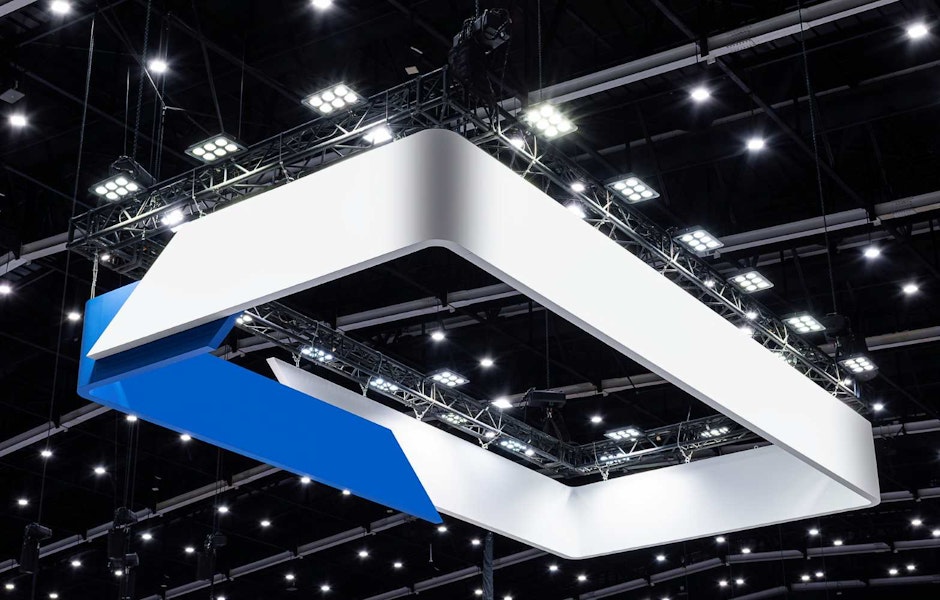
Truss displays are the bold, industrial-looking frameworks you often see at large exhibitions. They’re built with interconnected aluminium sections that can hold lighting rigs, banners, monitors - even hanging signage. Basically, they scream we mean business.
These are best for brands looking to create immersive or dramatic spaces. A truss system can be configured to showcase products, host live demos, or anchor a high-traffic zone within a larger stand. They’re not as quick to set up as pop-ups, of course, but if you’ve got the time and team, the results are spectacular.
One tip: integrate lighting thoughtfully. LED strips, spotlights, and backlit graphics can make your branding pop (literally). A truss display done right is an event in itself.
6. Custom-Built Displays
Here’s where creativity truly runs wild. Custom-built displays are bespoke structures designed specifically for your brand, space, and event goals. They’re the “wow factor” option - ideal for high-profile trade shows or product launches where you want to dominate attention.
With a custom design, you’re not limited to standard dimensions or materials. You can incorporate interactive screens, 3D product showcases, architectural elements, even sustainable materials that align with your company ethos.
Yes, they’re pricier. But when done well, they’re an investment in long-term brand recognition. People remember the booth that looked like a boutique experience or an art installation, not the one that blended into the background.
Still, it’s worth balancing ambition with logistics. Ask yourself: will it travel well? Can it be reused? We think creativity shines brightest when it’s practical too.
7. Portable and Hybrid Displays
Lastly, let’s talk about hybrid displays - portable systems that mix elements from multiple styles. Maybe you’ve got a modular frame combined with fabric graphics and banner stands, or a lightweight kit that can expand into a larger setup when needed.
These displays suit exhibitors who want flexibility without starting from scratch for every show. They’re cost-effective, adaptable, and often surprisingly durable.
A portable-hybrid setup also means you can scale your presence depending on the event’s importance. Big expo next month? Add the extra panels. Smaller networking fair? Strip it back. It’s like having two displays in one.
How to Choose the Right Display for Your Event
Choosing a display isn’t just about size or price - it’s about purpose. Start with your goals: are you trying to generate leads, showcase products, or raise brand awareness? Each objective demands a slightly different setup.
Also consider your audience and venue. A massive truss system might overwhelm a small conference room, while a modest pop-up might feel underwhelming at an international trade fair.
If you’re unsure, focus on flexibility and visual clarity. Displays that adapt to different spaces and clearly communicate your brand story tend to perform best. And if you’d like to go deeper, check out our blog on maximising visibility with the right trade show display - it’s full of practical insights for getting the most from your investment.
Key Takeaways
Trade show displays aren’t just decoration. They’re a visual handshake, a first impression that tells visitors what kind of brand you are. Whether you choose a simple roller banner or a fully bespoke installation, the key is alignment - between your brand identity, event goals, and the message you want to send.
We think it’s less about following trends and more about understanding what fits you. Sometimes, that’s a lightweight banner you can set up in minutes. Sometimes, it’s a show-stopping build that demands a crowd. Whatever you choose, let it speak clearly, confidently, and with a touch of personality.
Because in the end, standing out at a trade show isn’t just about size - it’s about strategy, story, and showing up with purpose.

